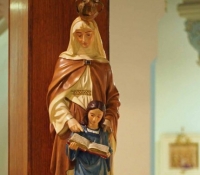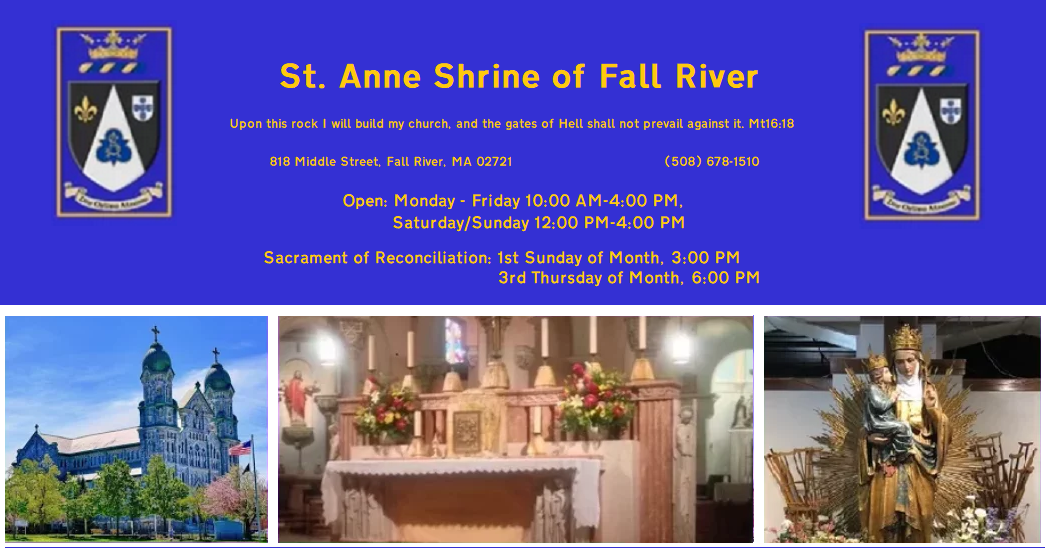
Saint Anne
Mother of the Blessed Virgin Mary
Feast Day: July 26th
What little we know about Saint Anne comes from the apocryphal Gospel of James (ca. 145 AD), also known as the Protoevangelium of James [PJ]. According to tradition, Anne (Hannah in Hebrew) was born in Bethlehem and married Joachim of Nazareth, both descendants of King David.
Joachim is described as “a rich and devout man,” who regularly gave to the poor and “made a double offering to the temple” in expiation for his sins (PJ 1:1). Because Anne was barren, the temple priest rejected Joachim’s sacrifice, as childlessness was interpreted as a sign of divine displeasure. There was no greater misfortune for a Jewish person than to be childless. Had not God promised to His people, through Abraham, “descendants as countless as the stars of the sky and the sands of the seashore” (Gen. 22:17)? Joachim consequently “went into the desert to fast and pray” for forty days and forty nights (PJ 1:4). But Anne remembered the faith of her ancestors, and with renewed courage prayed: “God of my fathers, bless me: Hear my prayer, as You blessed the womb of Sarah, and gave her a son Isaac!” (PJ 2:4). Her prayer was heard: “Behold, an angel of the Lord appeared to her and said: ‘Anne, Anne, the Lord has heard your prayer: You shall conceive and bear, and your offspring shall be spoken of in all the world’ ” (PJ 4:1). In an outpouring of faith, she who was to be Mary’s mother immediately consecrated her future offspring.
An angel appeared also to Joachim, saying: “Joachim, Joachim, God has heard your prayer. Go on your way, for your wife will conceive” (PJ 4:2). And Joachim offered a thanksgiving sacrifice of ten she-lambs without spot or blemish for the Lord God, twelve tender calves for the priests and elders, and a hundred goats for all the people. He then returned to Jerusalem and embraced Anne at the city gate (PJ 4:3-4).
There was an ancient belief that a child born of an elderly mother who had given up hope of having offspring was destined for great things. Parallels occur in the Old Testament in the cases of Sarah, mother of Isaac, and Hannah, mother of Samuel; and in the New Testament in the case of Elizabeth, mother of John the Baptist.
Tradition further narrates that in gratitude to God for the blessing of a daughter, Joachim and Anne vowed to consecrate Mary to God in the Temple as soon as her age permitted it. And so they did. Mary was scarcely three years old when, accompanied by her parents, she first set foot in the Temple. Here the noble child was admitted to the elect group of virgins consecrated to God (PJ 7).
It is commonly believed that the Blessed Virgin lost her beloved parents when she was about eleven. Just when she was living a life of angelic happiness in the house of the Lord, Mary had to taste of that chalice which fills the hearts of children with the most human sadness. The precise time of Joachim’s and Anne’s blessed passing is unknown, but the Fathers of the Church affirm that Mary became an orphan when still in the Temple. Yet her faith and hope made her see in the death of her parents the passage from exile to homeland, from earth to heaven. The time of Mary’s presentation in the Temple is unknown. The Church celebrates the feast of the Presentation of Our Lady on November 21st.
Anne, blessed above all others, we, too, bring you our reverence, for you have given birth to the girl from whom He will come Who is the basis of all our hope. Blessed, indeed, above all others, and blessed in your offspring! The tongues of all believers sing the praises of your child. Every voice is raised in joy at her birth. How worthy Anne is of praise, most worthy, for she received the message of God’s goodness, and brought forth such fruit that from it would come our Lord, Jesus. — St John of Damascus (8th cent.)
Devotion to Saint Anne

By Father Pierre E. Lachance, O.P.
Preached at Dominican Academy, 26 July 1992
Saint Anne:
The cult* of St Anne goes back to the early centuries of Christianity and appears to be intimately connected with the cult of the Blessed Virgin Mary, her daughter. Many feasts of Mary were also inseparably feasts in honor of St Anne, her mother. Such were the feasts of Mary’s conception and of her birth. The Immaculate Conception of Mary happened in the womb of Anne. The cult of St Anne was general in the East before it spread to the Western Church. We know that a church was dedicated to St Anne in Constantinople, the capital of the Byzantine Empire, around the year 550. Another existed in Jerusalem at the same time and is especially venerable because it was built over the crypt that was the house of Joachim and Anne, the house where Mary was born.
Since the official veneration of a saint regularly follows in the wake of a widespread private devotion, there can be no doubt that private devotion to St Anne began very early in the Eastern Church. By the 10th century, the Eastern Church observed three feasts in honor of St Anne: July 25, her special feast day; September 9, the day after Mary’s birthday; and December 9, right after the celebration of the Immaculate Conception of Mary.
The public cult of St Anne was probably introduced into the Western Church in the 8th century. In 1378, the feast of St Anne was celebrated for the first time on July 26 in England, soon to be observed throughout the Western Church.
Devotion to St Anne spread rapidly everywhere in the West. Confraternities were erected in her honor since the 13th century. Pilgrimages developed around the many churches or shrines dedicated to St Anne. The most famous are those of Duren in Germany, since 1501; Saint Anne d’Auray, in Brittany, France, since 1623; and Saint Anne de Beaupre in Canada, since 1670.
The devotion to St Anne was brought to the United States and Canada by the first missionaries of North America, who came from France at a time when St Anne was becoming famous through her Shrine in Brittany. Today, St Anne has hundreds of churches and shrines dedicated to her in the United States and Canada, where she is still one of the most popular and beloved saints.
Our own church of St Anne here was dedicated to St Anne by the founder of our parish in 1869. Not surprisingly, because Fr Montaubricq, our first pastor, was a native of Bordeaux, France, and with a name like Montaubricq, it is clear that his ancestors came from Brittany, where the famous Shrine of Saint Anne d’Auray is located.
Devotion to St Anne was natural to the Canadians who came to Fall River from Canada in the last century. They loved their shrine of St Anne de Beaupre, and the devotion to St Anne was widespread and traditional among the French Canadians. St Anne is the official patroness of the Province of Quebec.
After Fr Montaubricq came Fr Thomas Briscoe, second pastor of St Anne’s. An Irishman himself, he encouraged the devotion of his parishioners to St Anne by conducting an annual novena in preparation for the feast of St Anne.
Then came the French Dominicans in 1887. It was Fr Sauval who, in 1892, first organized pilgrimages to St Anne in his church. That was the old wooden church on Hunter Street. He invited the French pastors of the area to come with their parishioners on a pilgrimage to St Anne in Fall River. Traveling to St Anne de Beaupre was a long trip and expensive for poor immigrants. Coming to pray to St Anne at the Fall River Shrine became very appealing – so much so, that in 1892 Fr Sauval announced from the pulpit one Sunday a grand vision of his: to build a new and larger church that would some day become a national shrine in the U.S. like that of St Anne de Beaupre in Canada. Two years later, construction began and on the 4th of July, 1906 our beautiful church was completed and dedicated.
In those early times and for many years to come, pastors would come on an annual pilgrimage with groups of parishioners of 500, 1000, 1500 and more. They came by trolley car, by omnibus (i.e. horse-drawn busses) and even by boat from Providence and Pawtucket. On the boat, certain newspaper reports tell us that the people prayed, sang hymns and at times the priest accompanying them would preach a sermon. It was truly a spiritual event, not a pleasure excursion.
Is it any surprise that “Good Saint Anne” often rewarded the faith and the devotion of those pilgrims in marvelous ways? I have many hundreds of wonderful stories of healings and other favors obtained by those devotees of St Anne.
Later on, in 1905, came Fr Marchildon, whom most of us have known very well. Through his long ministry, the devotion to the saint developed at St Anne Shrine and so did miracles and healings.
The cult of St Anne and the supernatural blessings associated with it teaches us the importance of the saints in Christian life and the power of their intercession. The saints in heaven are part of our spiritual family. (Devotion to the saints is not as popular as it used to be. This is unfortunate.) In honoring them we give glory to God who honored them first. And as we become familiar with the saints, we are inspired to imitate their virtues and to draw closer to God. Amen.
* By “cult” (from the Latin cultus) Catholics mean the accumulation of prayers, hymns and other devotions extended to a particular saint, not the worship that is offered to God alone.
Prayer to Saint Anne
With my heart full of the most sincere veneration, I prostrate myself before thee, O glorious Saint Anne. Thou art that creature of privilege and predilection, who by thy extraordinary virtues and holiness didst merit from God the high favor of giving life to her who is the Treasury of all graces, blessed among women, the Mother of the Word Incarnate, the most holy Virgin Mary. By virtue of so lofty a privilege, do thou deign, O most compassionate Saint, to receive me into the number of thy true clients, for so I profess myself and so I desire to remain throughout my entire life.
Shield me with thine effectual patronage and obtain for me from God the power to imitate those virtues wherewith thou was so plentifully adorned. Grant that I may know and weep over my sins in bitterness of heart. Obtain for me the grace of most active love for Jesus and Mary, and resolution to fulfill the duties of my state of life with faithfulness and constancy. Save me from every danger that confronts me in life, and help me at the hour of death, that so I may come in safety to paradise, there to sing with thee, O most happy mother, the praises of the Word of God made Man in the womb of thy most pure daughter, the Virgin Mary. Amen.
Our Father, Hail Mary, Glory be, three times.
From the Enchiridion Indulgentiarum (1950), English ed. (Benziger Bros., 1957), no. 494.
